Hellbenders and the Excitement of Late Summer
by Linda Martinson
August is an exciting month as summer begins to wind down. For example, there are often some spectacular meteor showers in late July through August. The Perseids are one of the brighter meteor showers, and they occur every year between July 17 and August 24. This year they peaked (at night of course) between August 12 and 13. Our daughter is in charge of nighttime excitement at our house, and she put chairs out on the deck and woke us up to watch the sky on Saturday night, August 13. This year, however, the moon was full so the meteors were not so bright, but it was still exciting to bask in the full moon and catch glimmers of meteor flashes.
The Perseids meteors are named after the constellation Perseus because it lies in the same direction that the meteors seem to be coming from. The meteors are made up of tiny pieces of space debris of ice and rocks left behind from the Swift-Tuttle comet which last passed close to Earth in 1992. So the cloud of space debris that we occasionally see as meteors consists of particles ejected by the comet as it travels on a 133-year orbit. The Perseids peak when Earth passes through the densest and dustiest parts of the comet’s orbit.
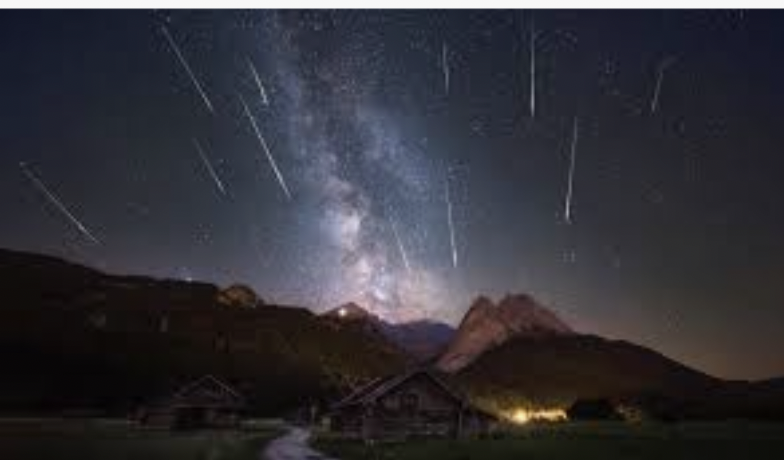
Perseids meteors
space.com
We have even more nighttime entertainment here at Richland Ridge in late summer into fall. At night when we turn everything off and open the windows, we hear a loud mixture of at least a dozen insect sounds, mostly produced by male katydids, tree crickets, and long-horned grasshoppers calling for mates. To sing, most of them raise their front wings and move them back and forth (stridulation). The sharp edge of one wing (the scraper) rubs against the ridge (the file) of the other wing producing a chirp or trill that is amplified by the wing membranes much like the resonating sound a violin makes when the bow is pulled across the strings.
Male tree crickets begin singing at dusk creating a series of clicking noises, which sound like a trill or a chirp. Their trills are short and uniformly spaced and they can be heard from a distance all summer long. Their songs are described as mellow, melodic, pleasant, and “almost defining a summer night”. Later, long-horned grasshoppers and katydids take over and sing loudly almost until morning. In most deciduous forests, it is the Common True Katydid that sings most often and the loudest. They are not commonly seen because they live high in tree tops, especially oaks. The True Katydid is large, green, and bulky and resembles a leaf. They have large forewings but cannot fly, although when they fall out of the trees (after a storm for example) they do walk along the ground to find another tree to climb.
True Katydids often form large synchronized choruses alternating their songs with a call-and-response rhythm between tree tops, usually drowning out every other sound in the area. When there are a large number of males in one location, each one will join one or the other of two singing groups. In this complicated alternation and synchrony arrangement, each male katydid is alternating with the neighbor he hears best, while at the same time synchronizing with the other males also alternating with that neighbor. This is a remarkable feat for insects, and results in a large and pulsating and compelling sound synchronization that can be frightening to people who haven’t heard it before. For example, the early Pilgrims wrote accounts about the terrifying insect sounds they heard at night in the late summer.
When the night temperatures begin to drop, the insects sing more and more slowly and their songs sound more creaky and “groaning” until they stop completely by October.
So enjoy the strangely comforting night insect sounds while they last.
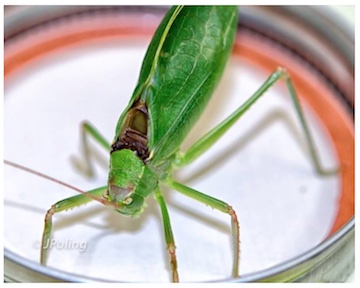
The Common True Katydid about 2 — 2.5 inches long
LM photo
And onto hellbenders! I have seen many references to hellbenders and I knew they are common in the French Broad River, but difficult to locate. And I had been told that they were not commonly found in our section of the West Fork, a tributary of the French Broad River. We have found them now, however, and close to home! In July we had a Richland Ridge picnic by the river, and a graduate student from Clemson spoke to us about his research on hellbenders in our stretch of the river. He had been monitoring one hellbender that had been injured and he scooped him up from the river, checked him out, and then showed him to us.
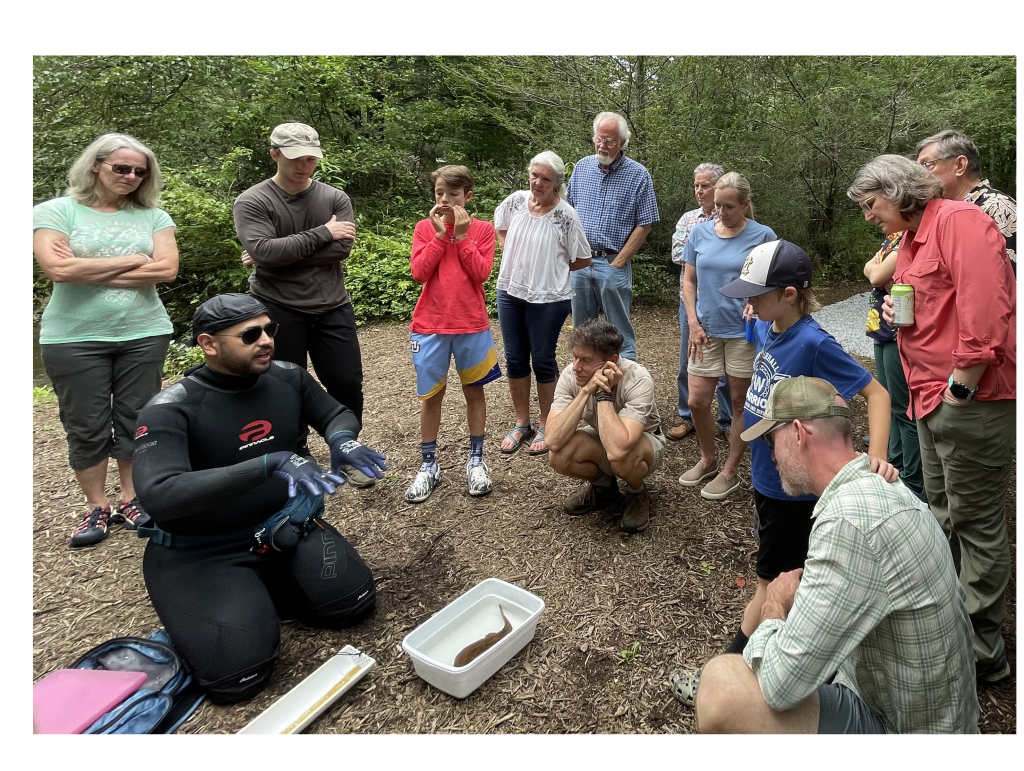
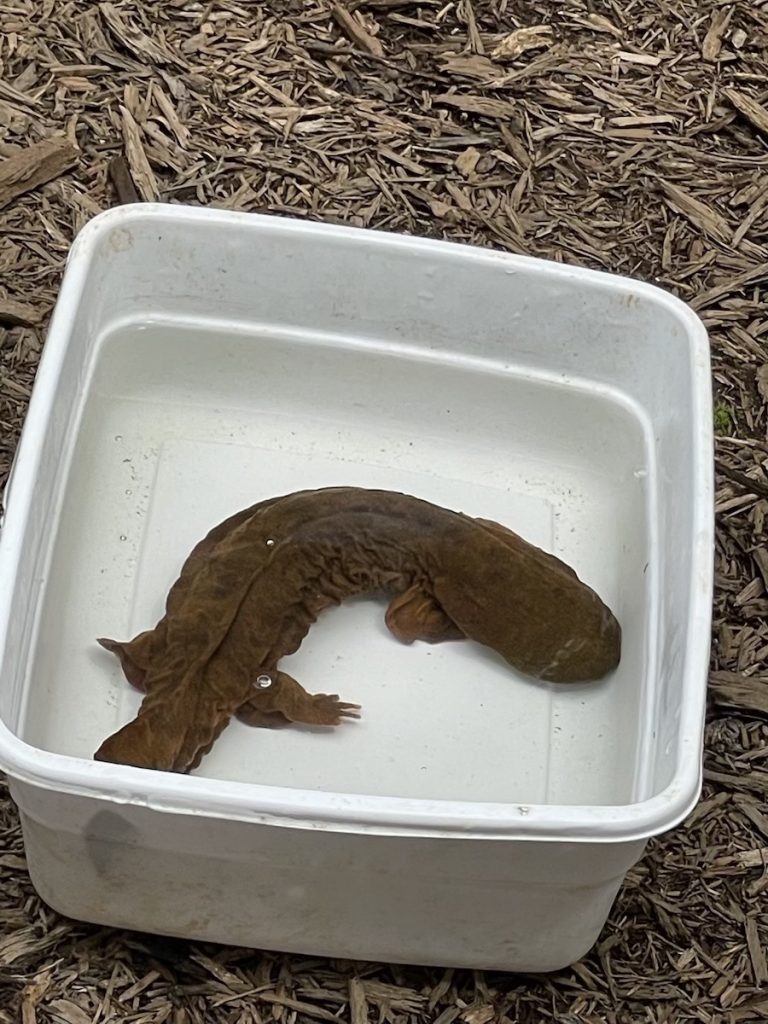
Hellbenders are one of only three giant salamanders found in the world. North Carolina has more than 65 species of salamanders, and 50 of them have been found in our mountains. The Eastern hellbender (Crypto-branchus a. alleganiensis) is one of the largest salamanders found in North Carolina and in the United States. Only one salamander, the amphiuma, is longer. It is more like an eel and quite interesting because it has one of the largest complements of DNA in the living world, around 25 times more than a human. But I digress. The salamander that joined our picnic was an Eastern hellbender.
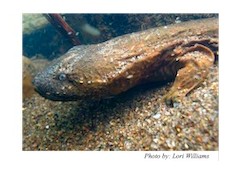
NC Wildlife Resources Commission
Eastern Hellbender
Photo: Lori William
Most hellbenders in our nearby rivers are probably no more than 16-17 inches long, but they can grow longer than 2 feet and weigh more than 2 pounds The color on their backs ranges from grayish brown to reddish brown, and they may have some darker spots or mottled patches. Their bellies are usually a solid lighter color. They have a flattened heads and bodies with a rounded snout and small eyes. Hellbenders are mostly nocturnal and catch much of their food by touch and smell. They are generally found in fresh, fast-running rivers, and they absorb dissolved oxygen into their lungs through their skin. Ideally, the river is fast enough to keep oxygen levels high but not so fast that the hellbenders can’t find the large, flat rocks and submerged trees they require for nests and safety from predators. If safe havens aren’t nearby in a river, hellbenders sometimes live in holes in stream banks.
Hellbenders are rather slimy and odd looking, but they are harmless and not at all venomous or toxic. Sadly, hellbenders are often killed because they do look somewhat scary. Hellbenders breed from September to early November, and the males guard their territory and dig out a large saucer-shaped nest for females to lay up to 500 eggs, each about 1/4 inch in diameter. Males fertilize the eggs with a milky fluid, and the eggs hatch into larvae in 10 to 12 weeks. The young hellbenders grow rapidly, about 3 inches a year, but there is high mortality especially among the younger and smaller hellbenders. A nest of 400 eggs may produce only 90 or fewer young hellbenders.

North Carolina Zoo image
We are fortunate to have hellbenders in our area. They were once common throughout the mid-eastern United States, but these remarkable giant salamanders have disappeared from many streams and rivers mostly because of declining water quality, over-collecting, and ignorant persecution. Because hellbenders are sensitive to water and other pollution, silt, and sediment, they have become a biological indicator of water quality. We are indeed fortunate to have relatively clean water here in the West Fork and in other tributaries of the French Broad River and other rivers in the area.
The national forests protect many of our mountain watersheds, but development, road construction, and poor land use practices, especially on steep slopes and in riparian areas, threaten not only the habitat of hellbenders but also of fish and other aquatic animals. Stream sediment and pollution have caused a persistent decline in water quality in our rivers and streams. Please report any sediment run-off or pollution that you find along the West Fork and other valuable French Broad tributaries in our area.
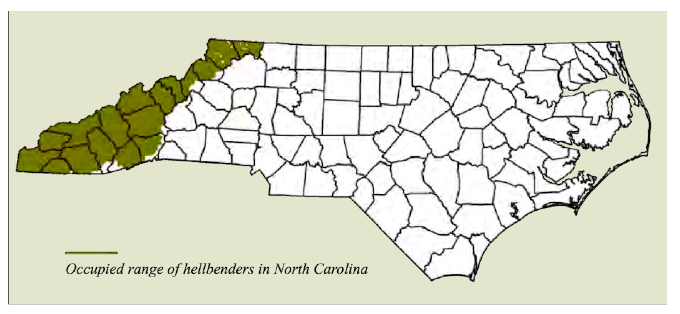
NC Wildlife Resources Commission 2012
Here is a more scholarly reference recommended by Daniel Knapp, the graduate student from Crimson who gave us a demonstration and description of hellbenders. Thank you again, Daniel!
The Hellbenders by Max Allen Nickerson and Charles Edwin Mays. Milwaukee Public Museum June 1972.

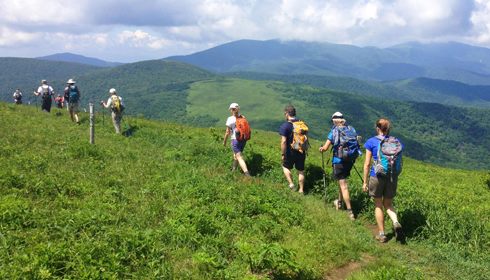





35 comments